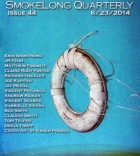“Junior in the Tunnels” blew me away. Pulled in by the narrator’s voice and humor, I was even more intrigued by how this unfolds like a mini-novel. How did this particular structure evolve?
I’m glad the story read like a mini-novel. That’s a very kind thing to say. The structure of this story tumbled together, and looking back, it was one of those ten-minute first drafts with quick scenes. I like to write/read things that have small sections that zip by.
The story evolved from the final scene, the birthday cake in the tunnel. I knew I wanted the narrator there to ask “an important question.” I knew the candles would blow out. I wrote it from the top down, from the opening dialogue, the bit of back story and the journey to the Mayweather, finally into its secret tunnels.
When I wrote the story’s first draft, I wrote it in order, so it went, 1, 2, 2 (accidentally putting 2 twice), 3, 4, 5 … and wound up retitling the 1st “2” section to “1.5” because it’s just data, nothing happens. We get a chunk of info about Junior, but the narrator and his girl are not “there.” Or maybe I’m lazy and didn’t want to make it six sections? Maybe I’m biased against six.
And yes, there is a bunch of humor in this piece. I’d like to think it’s funny on the surface, but probably it’s really there as self-defense, for the narrator especially. He’s got to joke around, he’s in a lot of pain and wants things to work out, but how often can things work out 100%? And this story is structured with a bunch of mystery suggested in it, so I look at the jokes as little clues, too.
Jokes as clues! This is double-duty writing, reaching the reader on two levels. When in the process do you look at what you have and start layering in meaning?
Plopping in “meaning” is tough, most of it happens accidentally. It happens when the characters talk. It slips out on its own, like letting a balloon go on a windy day. Probably most strongly in the second and third draft, I try to vaguely connect some dots.
I’m writing about the uncertainty and unreliability of ordinary life. Things can get strange and I don’t have big concrete answers. There are supposed to be explanations, but two things are working against the reader getting a totally satisfying answer. First, this writer doesn’t have the true answer to anything. Second, the narrator is even worse off. He doesn’t even know he’s got 36 candles.
The other night, I read the story to my wife while we were lying in bed. When it was all over, the candles snuffed out, she said, “What happens?!”
I said, “Damn, I don’t know for sure.”
It’s not that I didn’t imagine an ending beyond the last word. I could see it going down a few ways. I like when art lets you make up your own mind. Then it doesn’t matter what the writer knows or doesn’t. The story becomes as intelligent as the reader.
I asked my wife, “How do you think it ends?”
It’s not my sole business to tell her how I thought it ended. That’d be just one man’s small guess.
You talk about leaving the ending—the definitive ending—to the reader, but you also leave out other background information such as how Junior died. You trust the reader.
I definitely trust the reader. I assume they get things in the piece that are over my head, too.
What a joy I get out of reading “fan theories.” Not on my work; that hasn’t happened yet. But there’s a documentary called Room 237, which is loaded with examples of fan theories on Kubrick’s The Shining. I enjoy the connectivity of Kubrick’s work, and maybe even more, the analysis (even sometimes hare-brained of the fans.)
I don’t know much about “fan theories.” Do these analyses affect your writing and what “fan theories” do you think readers might come up with for this story?
The analysis is totally separate. It’s an after-the-fact thing. Like a bonus round or something. I’m a geek for loving the Game of Thrones Reddit thread, where non-book readers actively toss around theories about how the show will progress. Or even in some cases, those that have read the books dig through the text that is deep with foreshadowing, prophesy and myth. “Junior in the Tunnels” is a kind of urban myth.
How the story could end?
1. Nothing happens, the candles go out but that’s it. This story is realism.
2. The candles go out as an “answer.” The answer is ambiguous though. It could be darkness as a “no.” Or a darkness as a “we’re done.” This would assume the story is supernatural.
3. Dee had something to do with Junior’s death in the tunnel, and by extension this will have implications for the narrator.
4. Junior might not be a real person at all. There’s no evidence of him, he’s really just a stand-in for “the love of youth.”
5. The narrator blows the candles out.
6. Dee blows the candles out.
7. The candles went out because there’s a strong draft coming from a door or other passage opening. Someone’s coming.
Does this work of fiction draw at all from your real life?
Yes! As a kid, I grew up in a town where a convalescent home was rumored to have tunnels that went underneath the lake in front of the facility. The tunnels had been built by Al Capone to use as an escape route in case the FBI showed up. Originally the home was a swanky ’20s hotel popular during prohibition. The pines around it were ripe for exploring. As kids, we searched for the tunnels, but never found them. Most towns have something like that, I guess, steeped in mystery, adventure, danger. I’ve written about the Mayweather before—it’s where Jimmy’s wife goes in Tollbooth to seek counseling. Since she was there in 1994, it’s been closed. As closed as can be, I guess.



 The core workshop of SmokeLong Fitness is all in writing, so you can take part from anywhere at anytime. We are excited about creating a supportive, consistent and structured environment for flash writers to work on their craft in a community. We are thrilled and proud to say that our workshop participants have won, placed, or been listed in every major flash competition. Community works.
The core workshop of SmokeLong Fitness is all in writing, so you can take part from anywhere at anytime. We are excited about creating a supportive, consistent and structured environment for flash writers to work on their craft in a community. We are thrilled and proud to say that our workshop participants have won, placed, or been listed in every major flash competition. Community works.